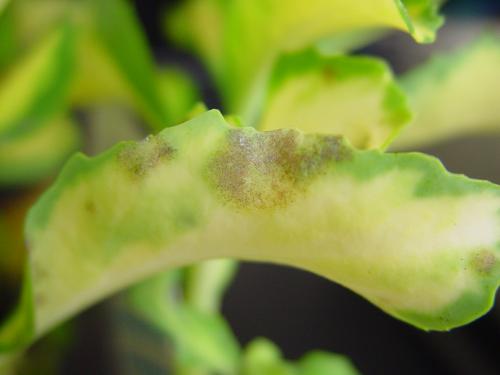Powdery mildew
July 7, 2015
Mildews
Pathogen
Multiple including Erysiphe spp., and Microsphaera spp.
Hosts
Achillea, Aquilegia, Aster, Coreopsis, Clematis, Delphinium, Helianthus, Lupinus, Monarda, Phlox, Pulmonaria, Rudbeckia, Salvia, Scabiosa, Solidago, Sedum, Veronica and Viola.

Heavily infected Salvia foliage.
Symptoms
White, talcum-like colonies on the leaf surface. Chlorotic spots may be present on the leaf surface opposite the colony. Under favor-able conditions, colonies enlarge and coalesce, blighting larger sections of foliage. Severe infections on some hosts cause defoliation. Infection on sedum causes slightly raised scabby lesions; powdery colonies may not be readily visible.
Spread
Powdery mildew spores are air-disseminated and subsequently infect leaves and stems of plants under humid conditions.

Necrotic lesions caused by powdery mildew on Sedum. Symptoms are similar on other succulents.
Management
Scout plantings for signs of disease. Timely fungicide applications made early in the disease epidemic are more effective at control. Reduce the relative humidity, if possible – high levels are conducive to powdery mildew development. Increase plant spacing to promote air movement around plants. Fungicide applications may be necessary. Use both systemic and protectant products. Powdery mildew fungi can develop resistance to systemic fungicides. To delay the development of fungicide resistance, these products should not be used exclusively.
Note
Although many plants are affected by powdery mildew, each powdery mildew fungus has a specific host range, usually affecting closely related plants. For example, Phlox infected with powdery mildew will not serve as a source of inoculum infecting Aquilegia.
Print a PDF of this page: Powdery mildew text



 Print
Print Email
Email



